Electric vehicles (EVs) are transforming the automotive industry, but their success hinges on one critical component—Electric Vehicle Charging Infrastructure.
As we move into 2025, advancements in charging technology, government policies, and market trends are reshaping how EVs are powered.
Whether you’re an EV owner, investor, policymaker, or entrepreneur, understanding the latest developments in EV charging infrastructure is essential. This comprehensive guide explores:
- Types of EV charging stations
- Key EV charging connector types
- Electric vehicle charging station requirements
- Current EV charging infrastructure problems and solutions
- The latest EV charging infrastructure trends
- Business opportunities like EV charging station franchises
By the end, you’ll have a clear roadmap of the EV charging infrastructure 2025 landscape.
What Is Electric Vehicle Charging Infrastructure?
Electric Vehicle Charging Infrastructure refers to the network of charging stations, power grids, software, and hardware that enable EVs to recharge. It includes:
- Home charging stations (Level 1 & Level 2)
- Public charging stations (Level 2 & DC Fast Charging)
- High-power charging (HPC) networks for long-distance travel
- Smart charging solutions (AI-powered load balancing, V2G)
Why Is EV Charging Infrastructure Important?
- Reduces range anxiety – More stations mean fewer worries about running out of power.
- Supports mass EV adoption – Without sufficient infrastructure, EV growth stalls.
- Enables renewable energy integration – Smart charging aligns with solar/wind power.
- For a deeper dive, check out this Electric Vehicle Charging Infrastructure PDF (link to downloadable report).
Types of EV Charging Stations (2025 Update)
The EV charging infrastructure in 2025 offers multiple charging levels, each suited for different needs.
1. Level 1 Charging (120V AC)
- Best for: Overnight home charging
- Charging Speed: 3-5 miles per hour
- Pros: Uses standard outlets, low cost
- Cons: Too slow for daily long-distance drivers
2. Level 2 Charging (240V AC)
- Best for: Homes, workplaces, public stations
- Charging Speed: 12-80 miles per hour
- Pros: Faster than Level 1, widely available
- Cons: Requires professional installation
3. DC Fast Charging (DCFC) (400V-800V DC)
- Best for: Highways, commercial fleets
- Charging Speed: 80% in 20-30 minutes
- Pros: Essential for long trips
- Cons: High cost, potential battery wear
4. Emerging Tech: Wireless & Bidirectional Charging
- Wireless (Inductive) Charging: Park-and-charge convenience (no cables needed).
- Bidirectional (V2G) Charging: EVs supply power back to the grid, stabilizing energy demand.
EV Charging Connector Types (2025 Compatibility Guide)
Not all EVs use the same plug. Here’s the latest on EV charging connector types:
| Connector Type | Compatible Vehicles | Max Charging Speed |
|---|---|---|
| Type 1 (SAE J1772) | Older EVs, PHEVs | Up to 7.4 kW (L2) |
| Type 2 (Mennekes) | European EVs, Tesla | Up to 22 kW (L2) |
| CCS (Combo 1 & 2) | Most new EVs (US & EU) | Up to 350 kW (DCFC) |
| CHAdeMO | Nissan Leaf, Mitsubishi | Up to 150 kW (DCFC) |
| Tesla NACS | Tesla & Partner Brands | Up to 250 kW (DCFC) |
Key Trend: Tesla’s North American Charging Standard (NACS) is becoming the dominant connector in the US by 2025.
Electric Vehicle Charging Station Requirements

Setting up an EV charging station involves several key considerations:
1. Power Supply & Grid Demand
- Home Chargers: 240V circuit (Level 2)
- Public Stations: 50 kW–350 kW (DCFC)
- Grid Upgrades Needed: Utilities must support high-power demand.
2. Location & Accessibility
- Urban Areas: High-density charging hubs
- Highways: Fast-charging corridors every 50-100 miles
- Workplaces & Malls: Destination charging
3. Government Regulations & Incentives
- US: NEVI Program ($5B investment in charging networks)
- EU: AFIR (mandates charging stations every 60 km on highways)
- Tax Credits: Up to 30% off installation costs
EV Charging Infrastructure Problems & Solutions
Despite growth, EV charging infrastructure still faces challenges:
| Problem | Solution |
|---|---|
| Charging Anxiety | More stations + real-time availability apps |
| Grid Overload | Smart charging + battery storage |
| High Installation Costs | Government subsidies + franchise models |
Case Study: California’s “Charge Smart” initiative uses AI to balance grid load during peak hours.
EV Charging Infrastructure Report – 2025 Trends

The latest EV charging infrastructure report highlights:
- Market Size: $140B by 2025 (30% CAGR)
- Key Players: Tesla, ChargePoint, Electrify America, Shell Recharge
- Smart Charging Growth: AI-powered load management
- Renewable Integration: Solar-powered charging stations
- Prediction: By 2030, 50% of public chargers will be ultra-fast (350kW+).
EV Charging Station Franchise Opportunities
Want to invest in the EV charging infrastructure boom? Consider a charging station franchise:
Startup Cost: 50K–500K (varies by scale)
Revenue Models: Pay-per-use, subscriptions, ads
Best Locations: High-traffic retail, highways
Top Franchise Options:
ChargePoint (B2B-focused)
EVgo (Public fast-charging)
Tesla Supercharger Network (Expanding to non-Tesla EVs)
The Future of EV Charging Infrastructure
By 2030, expect:
- 5-Minute Ultra-Fast Charging (350kW+)
- Autonomous Charging (Robotic plug-in systems)
- Solar-Powered Off-Grid Stations
The Road Ahead for EV Charging Infrastructure
The Electric Vehicle Charging Infrastructure of 2025 is faster, smarter, and more accessible than ever. Whether you’re an EV driver, investor, or entrepreneur, now is the time to get involved.
Ready to explore EV charging solutions for your business?
👉 Contact Us Today!





